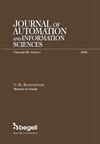利用序列聚类方法从模拟物联网数据中识别混合时间自动机
Q3 Engineering
Journal of Automation and Information Sciences
Pub Date : 2021-09-01
DOI:10.34229/1028-0979-2021-5-3
引用次数: 0
摘要
在工业物联网(IIoT)系统中,时间自动机为诊断和控制任务提供了非常有用的抽象。应用它们需要自动机以被动在线的方式学习,只使用正样本。这种学习由混合时间自动机(HTA)和OTALA算法支持,但需要一系列离散事件,而不是IIoT中常见的连续模拟时间序列。最近,a . von Birgelen、O. Niggemann等人尝试用自组织地图(SOM)和分水岭变换对观测结果进行预处理,但结果模型在一些现实世界的系统中被证明是无效的。本文采用基于增量模型的聚类(IMCF)从模拟IIoT数据中学习时间自动机。IMCF是一种顺序算法,它在线处理观察到的时间序列,并将它们分成一系列离散状态,它们之间有清晰或模糊的过渡。然后将此类转换视为与OTALA进行HTA识别所需的事件。在工业物联网系统的情况下评估获得的模型,该系统已被证明对现有建模技术具有挑战性。实验结果表明,模型性能提高了24.9 ~ 76.8%,表明用IMCF进行离散化对HTA识别具有较高的信息量。最后,讨论了在工业物联网中应用HTA的更广泛视角,并将剩余的主要限制确定为状态转换的离散性质,以及缺乏对转换的长期记忆。本文章由计算机程序翻译,如有差异,请以英文原文为准。
USING SEQUENTIAL CLUSTERING TO IDENTIFICATION OF HYBRID TIMED AUTOMATA FROM ANALOG IIOT DATA
In Industrial IoT (IIoT) systems, timed automata provide a highly useful abstraction for diagnosis and control tasks. Applying them requires automaton to be learned in passive online manner using positive samples only. Such kind of learning is supported by Hybrid timed Automata (HTA) and algorithm OTALA, but requireds a sequence of discrete events rather than continuous analog time series typically found in IIoT. Recent attempts to cover this gap, taken by A. von Birgelen, O. Niggemann, and others, involved pre-processing observations with a self-organized map (SOM) and watershed transform, yet resulting models have proven ineffective in some real-world systems. In this paper, incremental model-based clustering (IMCF) is employed to learn timed automaton from analog IIoT data. IMCF is a sequential algorithm that processes observed time-series online and splits them into a sequence of discrete states with either crisp or fuzzy transitions between them. Such transitions are then treated as events required for HTA identification with OTALA. Obtained models are evaluated in a case of IIoT system that has proved to be challenging for existing modelling techniques. Experimental results show 24,9–76,8% increase in model’s performance and suggest that discretizing obtained with IMCF has higher informativeness for HTA identification. Finally, wider perspectives of applying HTA in IIoT are discussed, and remaining principal limitations are identified as discrete nature of state transitions, and lack of long-term memory for transitions.
求助全文
通过发布文献求助,成功后即可免费获取论文全文。
去求助
来源期刊

Journal of Automation and Information Sciences
AUTOMATION & CONTROL SYSTEMS-
自引率
0.00%
发文量
0
审稿时长
6-12 weeks
期刊介绍:
This journal contains translations of papers from the Russian-language bimonthly "Mezhdunarodnyi nauchno-tekhnicheskiy zhurnal "Problemy upravleniya i informatiki". Subjects covered include information sciences such as pattern recognition, forecasting, identification and evaluation of complex systems, information security, fault diagnosis and reliability. In addition, the journal also deals with such automation subjects as adaptive, stochastic and optimal control, control and identification under uncertainty, robotics, and applications of user-friendly computers in management of economic, industrial, biological, and medical systems. The Journal of Automation and Information Sciences will appeal to professionals in control systems, communications, computers, engineering in biology and medicine, instrumentation and measurement, and those interested in the social implications of technology.
 求助内容:
求助内容: 应助结果提醒方式:
应助结果提醒方式:


